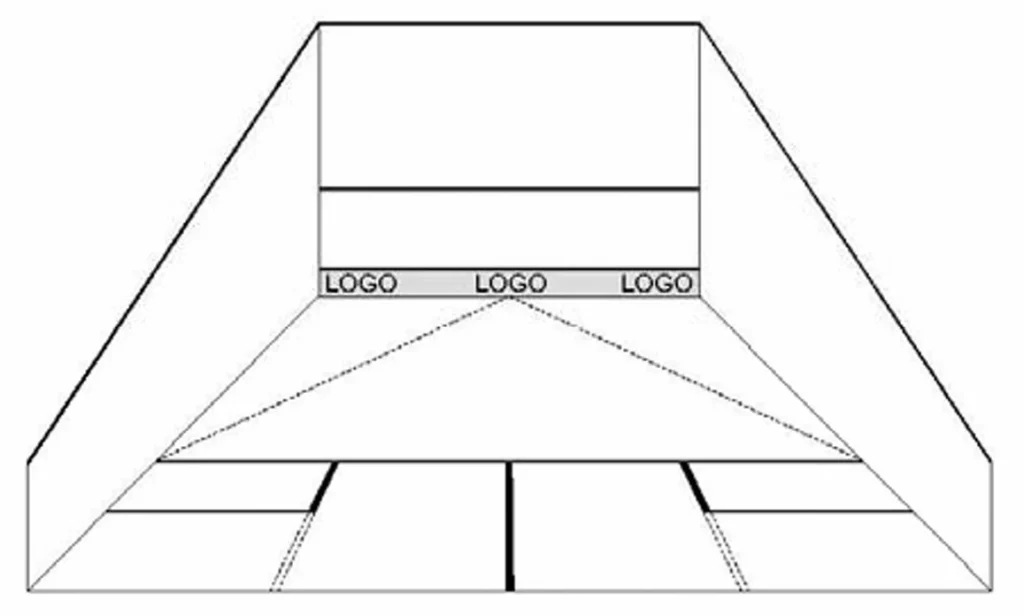Squash is a fast-paced, high-intensity racket sport played by two or four players within a four-walled court. Known for its cardiovascular benefits, agility demands, and strategic gameplay, squash has gained popularity worldwide, particularly in countries like the UK, Egypt, the USA, and India.
With an increasing number of professional tournaments, squash is now recognized as a sport that enhances physical fitness, mental sharpness, and social interaction.
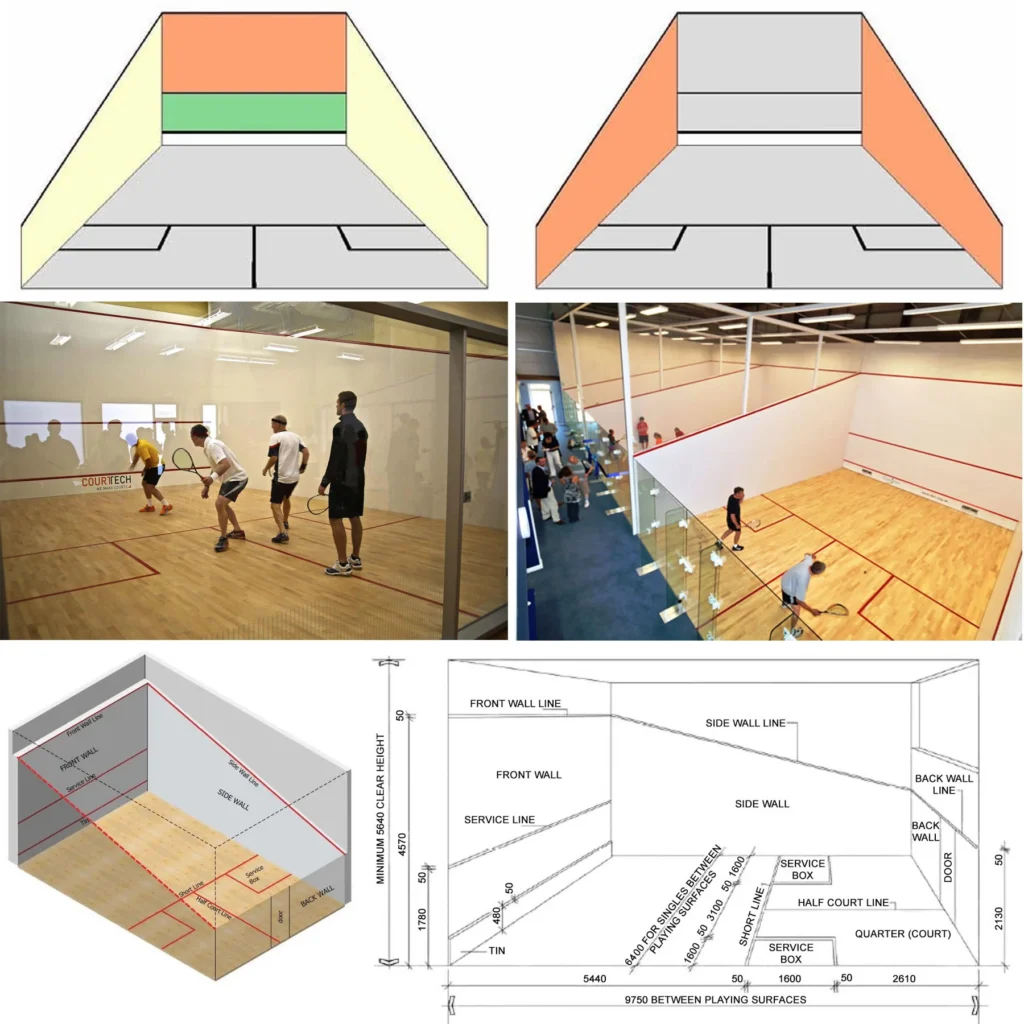
A well-designed squash court is crucial for ensuring a fair and enjoyable game. Proper court dimensions, high-quality flooring, adequate lighting, and well-ventilated spaces significantly impact player performance and safety. A substandard court can lead to poor ball bounce, excessive glare, or even injuries.
Whether for professional tournaments or recreational use, investing in a properly designed squash court enhances the overall playing experience and extends the longevity of the facility.
If you want to know about the Types of slabs or Permeable concrete or Islamic architecture, please click the link.
1) Field of play
The World Squash Federation (WSF) has established official court dimensions to ensure consistency and fairness in the game. These regulations apply to both singles and doubles squash courts, with some variations in size.
i) Court Dimensions and Tolerances
The plan dimensions of the singles court, measured 1 metre above finished floor level, shall be:
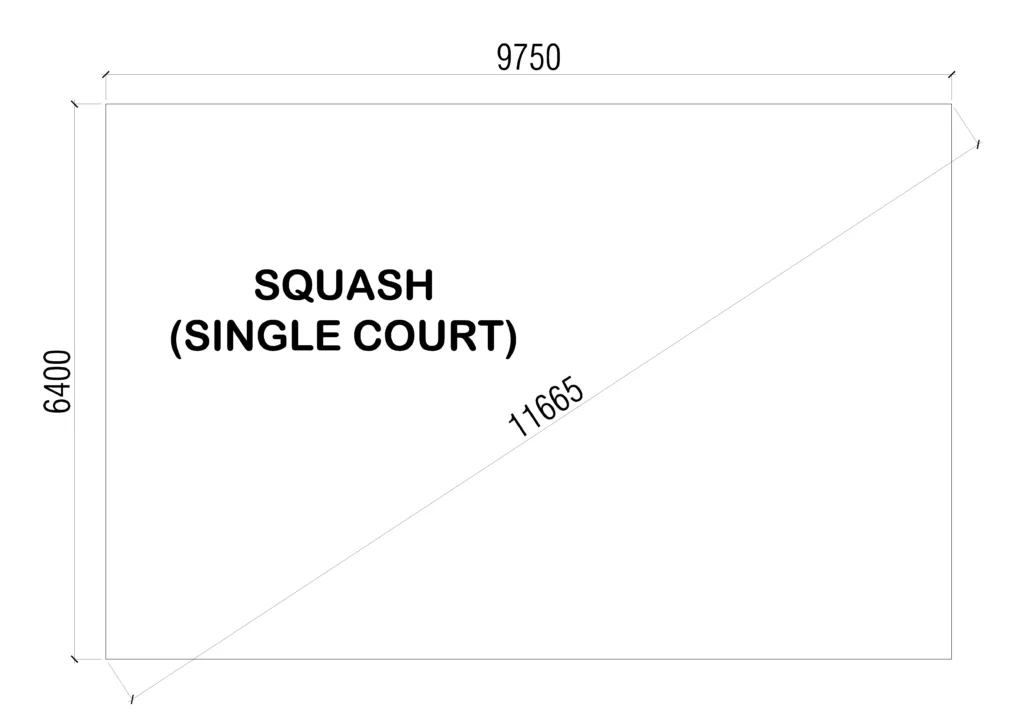
- Length: 9750 mm plus or minus 10 mm
- Width: 6400 mm plus or minus 10 mm
- Diagonals: 11665 mm plus or minus 25 mm
The plan dimensions of the standard doubles court, measured 1 metre above finished floor level, shall be:
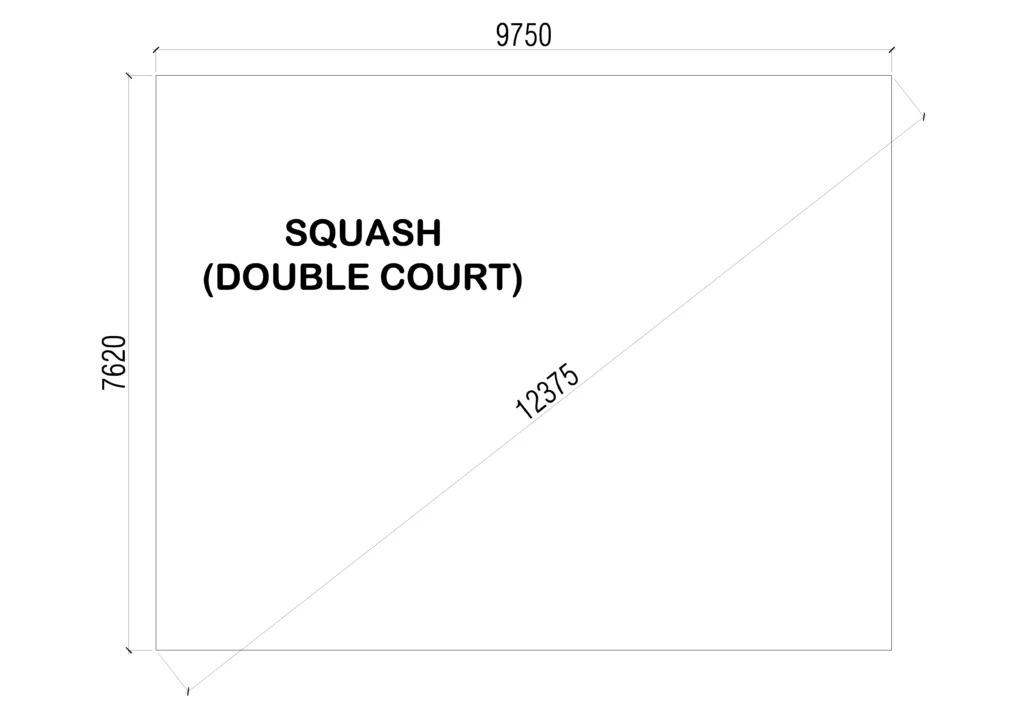
- Length: 9750 mm plus or minus 10 mm
- Width: 7620 mm plus or minus 10 mm
- Diagonals: 12375 mm plus or minus 25 mm
Note: For WSF recognised World and Regional events and Commonwealth Games, the width of the court between playing surfaces has been expanded from 7620mm to 8420mm and the height above the floor to the top of the tin shall be 330mm.
ii) Clear Height
The clear height above finished floor level (i.e. the height to the underside of the lowest obstruction) over the whole of the court shall be not less than 5.64 m. The clear height shall be measured to the underside of the lowest obstruction including lights.
iii) Court Markings
Generally all court markings shall be 50 mm wide and contrast in colour to adjoining surfaces, all wall markings shall be the same colour and all floor markings shall be the same colour.
All court markings shall be straight to within plus or minus 2 mm in 3 metres.
The maximum variation from the correct position of any court marking at any point shall not exceed 5 mm, except that the Tin shall not be more than 2 mm from the correct height at any point.
There shall be three horizontal court markings on the front wall:
- the front wall line
- the service line
- the upper 50mm of the Tin.
The lower edge of the front wall line shall be 4570 mm above finished floor level. The line shall not project into the space above the court and shall ideally be so shaped as to deflect any ball striking it.
The lower edge of the service line shall be 1780 mm above finished floor level. The line shall be marked on the surface of the wall and shall not deflect in any way any ball striking it.
The top of the Tin shall be 480 mm above the finished floor level and the upper 50mm shall project into the court by not more than 15 mm at the top and 45 mm at the bottom and shall be shaped so as to deflect any ball striking it. All edges of the Tin shall be rounded. Below the upper 50mm, for the full width of the court, the Tin shall be constructed in such a manner as to make a distinctive noise when struck by the ball.
If the court has a transparent front wall it is recommended that the wall extends to a minimum height of 5250 mm above the floor.
As an alternative to the Tin electronic devices may be used providing they : Emit an audible sound when the ball passes within the 50 mm line zone that they replace and be unaffected by external condition such as vibrations, atmospherics or illuminance variations.
Back Wall
There shall be one horizontal court marking on the back wall, the back wall line.
The lower edge of the line shall be 2130 mm above finished floor level except that if the court has a transparent wall 2130 mm (plus or minus 5 mm) high above finished floor level the back wall line shall be omitted.
If the court has a transparent back wall which is 2180 mm or more high above finished wall level, the back wall line shall be marked on the inside (court) face of the wall.
No transparent wall with a height of between 2130 mm and 2180 mm (both dimensions plus or minus 5 mm) high above finished floor level shall be allowed.
If the court has a solid back wall, the back wall line shall ideally be so shaped as to deflect any ball striking it or shall be marked on the bottom edge of a sounding board not less than 200 mm deep across the full width of the court. Any such sounding board may project up to 5mm into the court.
Side Walls
There shall be one court marking on each side wall, the side wall line. The line shall join the ends of the front wall line and the back wall line. If the back wall line is omitted as allowed above, the side wall line shall join the ends of the front wall and an imaginary back wall line.
The side wall lines shall not project into the court but should ideally be so shaped as to deflect any balls striking them.
If the court has a transparent side wall it is recommended that the wall extends to a minimum height of 5250 mm above the floor for at least the first 2000 mm back from the front wall.
Floor Marking
There shall be four court markings on the floor:
- the Short Line
- the Half Court Line
- the Service Boxes (2).
Court markings on the floor shall be flush with the finish and be non-slip.
The Short Line shall be parallel to the front and back walls of the court. The distance to the nearest edge of the Short Line from the Back Wall shall be 4260 mm. The Short Line shall be marked for the full width of the court.
The Half Court Line shall be parallel to and equidistant from the side walls. It shall run from the back wall to the Short Line.
There shall be two Service Boxes, one on each side of the court behind the Short Line.
Each service box shall be square with internal sides of 1600 mm and shall be bounded on three sides by lines (one of each shall be a part of the short line) and on the fourth side by one of the side walls).
iv) Court Walls
Construction
Each wall of the court shall be of the same construction over the whole of the playing area. Adjacent walls need not be of the same construction.
Strength
The walls of the court and all components of them shall be capable of withstanding all the stresses which may be placed upon them in normal play and shall not suffer any permanent or temporary damage as a result of The impact of balls or rackets:
Finishes of court walls
All playing walls of the court shall have a hard smooth finish.
Any front or side walls, or any transparent panel in the playing surface of the front or side walls, shall be treated and/or lit in such a manner as to make it non-reflecting when viewed from inside the court.
Ball Rebound
The ball shall rebound truly on striking all parts of the playing walls. The ball rebound shall be consistent over the whole area of each wall.
Joints in Playing Surfaces
Any open joint in the finish of a wall of panel construction shall:
- not deflect the rebound of the ball in any way
- not be wider than 2 mm in the plane of the wall surface
Wall to Wall Junctions
There shall be no protrusions of any kind into the court at the junction of one wall with another. Wall to Floor Junctions
v) Moveable walls
While courts are provided with moveable walls these walls shall comply in all aspects with the above as if they are of a permanent construction.
vi) The Door
Position of the Door – It is recommended that the door to the court is located in the middle of the back wall, but in any event should be in the middle third and shall open into the court.
Inside Surface of the Door – The inside surface of the door shall be plane and shall be flush with the adjacent wall surfaces when the door is closed. It shall be fitted with a flush handle and a restraining device which shall stop the door opening through 180 degrees and hitting the court wall.
The door shall match the colour, texture and ball rebound characteristics of the adjacent wall surfaces as closely as possible and shall be fitted with a latch or other mechanism which will prevent the door opening following an impact of a player with it on the court side.
Size of the Door – The door shall not normally be more than 900 mm wide and 2130 mm high.
vii) The Floor
Finish
The floor shall be hard, smooth, have limited spring and provide a firm footing in normal play.
The floor shall either be: able to absorb small amounts of moisture without becoming slippery
The floor shall be kept clean of all rubber, dust particles and other depositions which may reduce its slip resistance.
Resilience
The bounce of the ball shall be of even height and pace over the whole area of the floor.
viii) The ceiling and out of court areas
The ceiling shall have a plain matt finish and shall be white or a light colour against which the players shall be able to sight the ball without difficulty. The minimum reflectance value shall be 80% or below.
Roof Lights – There shall be no windows or other areas of glazing over any part of the court. If windows are provided in any walls above or adjoining the court they shall be provided with blinds.
ix) The use of colour and designs
There shall be no more than three different colours on the wall playing surfaces within the court.
- Each of the side walls shall be of one colour and each side wall shall be the same colour.
- The front wall may be two colours, one below and one above the service line. The front wall colours need not be the same colour as the side wall colours.
- The floor shall have no more than two colours and each colour shall be bounded on at least two sides by the floor markings.
x) Lighting
The court shall be lit by artificial light. The level of illumination measured 1000 mm above the finished floor shall be:-
- Recommended standard 500 lux
- Minimum standard 300 lux
- TV standard 1200 lux
- The walls of the court shall be lit in such a way as to appear evenly and uniformly illuminated and the lux levels shall not vary at any point by more than 15% from the average level of illumination.
xi) Heating and ventilation
Temperature
It is recommended that a Squash court shall be provided with a heating and/or air conditioning system capable of maintaining a temperature of between 10 and 25 degrees Celsius with an ideal range of 15 to 20 degrees Celsius.
Ventilation System
The court shall be provided with a ventilation system which shall provide not less than four complete air changes per hour when the court is in use.
Location of Grilles and Other Equipment
The only part of the court which may be used as a location for any heating or ventilation equipment shall be below the top 50mm of the Tin on the front wall, provided that the sounding characteristics are maintained and that there are no projections into the court.
No part of any heating or ventilating or other equipment may project into the clear space above the court excepting that equipment may be mounted on the front wall above the playing surface provided that: no part of any such equipment is less than 5400 mm above floor level in the court
No part of any such equipment projects more than 150 mm into the clear space above the court and no shadows are thrown onto the front wall.
3) Dimensions of a Singles Court
A Squash Court is a rectangular box with four vertical walls of varying height; being the Front Wall, Side Walls and Back Wall. It has a level floor and a clear height above the court area.
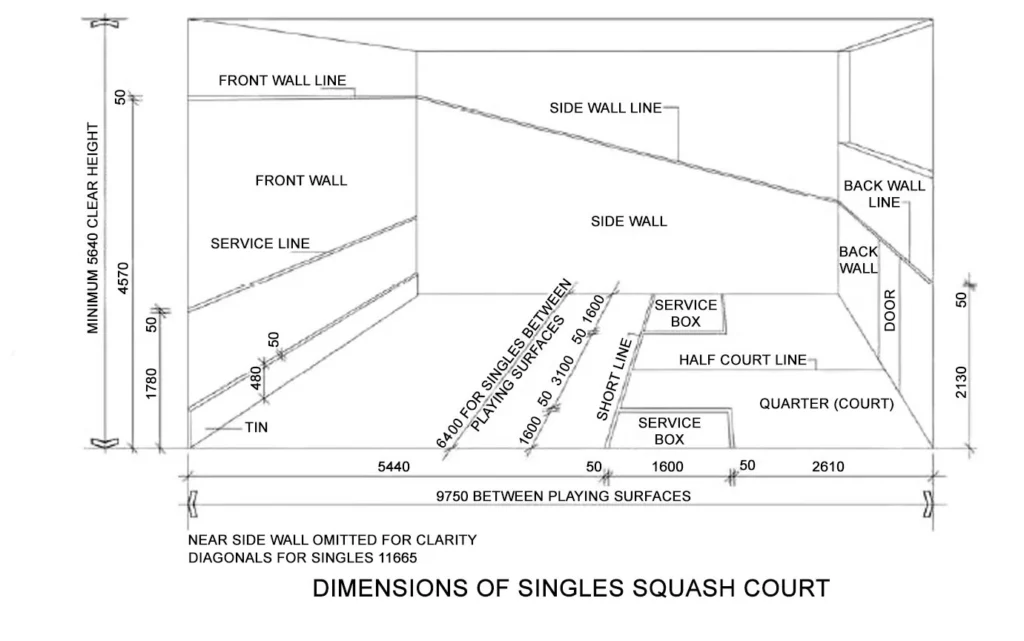
Dimensions
Length of court between playing surfaces – 9750 mm
Width of court between playing surfaces – 6400 mm
Diagonal – 11665 mm
Height above floor to lower edge of Front Wall Line – 4570 mm
Height above floor to lower edge of Back Wall Line – 2130 mm
Height above floor to lower edge of Service Line on Front Wall – 1780 mm
Height above floor to the top of the Tin – 480 mm
Distance to nearest edge of Short Line from Back Wall – 4260 mm
Internal dimensions of Service Boxes – 1600 mm
Width of all lines and the upper section of the Tin – 50 mm
Minimum clear height above the floor of the court – 5640 mm
Notes
- The Side Wall line is angled between the Front Wall Line and the Back Wall Line.
- The Service Box is a square formed by the Short Line, the Side Wall and two other lines marked on the floor.
- The length, width and diagonal of the court are measured at a height of 1000 mm above the floor.
- It is recommended that the Front Wall Line, Side Wall Line, Back Wall Line and upper 50mm of the Tin are shaped so as to deflect any ball that strikes them.
- No part of the upper section of the Tin shall project from the Front Wall by more than 45 mm.
- It is recommended that the door to the court is in the centre of the Back Wall.
- The general configuration of a Squash Court, its dimensions and its markings are illustrated on the diagram.
4) Dimensions International Doubles Court
A Squash Court is a rectangular box with four vertical walls of varying height; being the Front Wall, Side Walls and Back Wall. It has a level floor and a clear height above the court area.
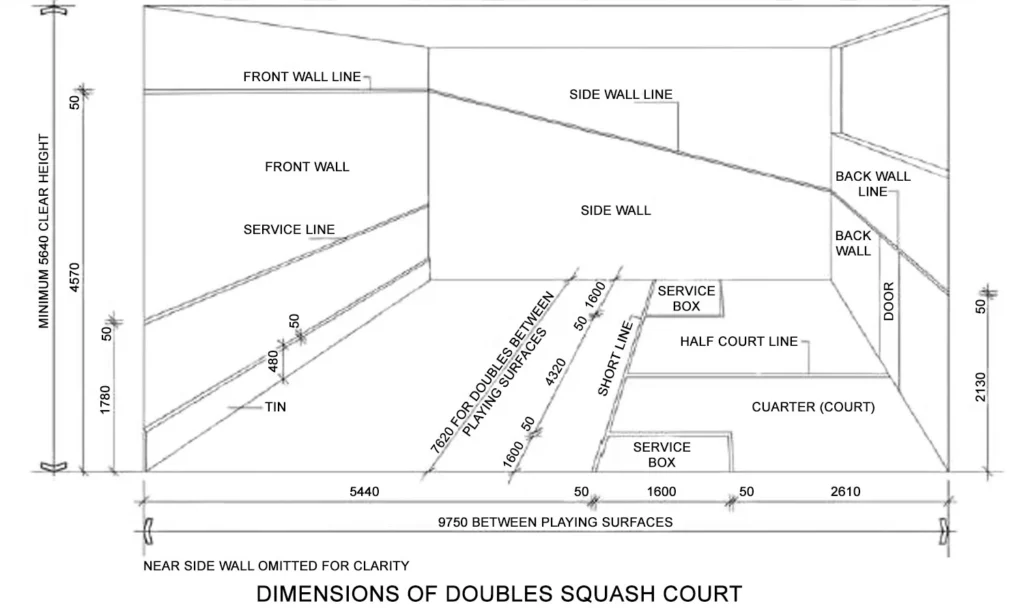
Dimensions
Length of court between playing surfaces – 9750 mm
Width of court between playing surfaces – 7620 mm or 8420 mm (Note 8)
Diagonal – 12375 mm
Height above floor to lower edge of Front Wall Line – 4570 mm
Height above floor to lower edge of Back Wall Line – 2130 mm
Height above floor to lower edge of Service Line on Front Wall – 1780 mm
Height above floor to the top of the Tin – 480 mm or 330 mm (Note 8)
Distance to nearest edge of Short Line from Back Wall – 4260 mm
Internal dimensions of Service Boxes – 1600 mm
Width of all lines and the upper section of the Tin – 50 mm
Minimum clear height above the floor of the court – 5640 mm
Notes
- The Side Wall is angled between the Front Wall Line and the Back Wall Line.
- The Service Box is a square formed by the Short Line, the Side Wall and two other lines marked on the floor.
- The length, width and diagonal of the court are measured at a height of 1000 mm above the floor.
- It is recommended that the Front Wall Line, Side Wall Line, Back Wall Line and upper 50mm of the Tin are shaped so as to deflect any ball that strikes them.
- No part of the upper section of the Tin shall not project from the Front Wall by more than 45 mm.
- It is recommended that the door to the court is in the centre of the Back Wall.
- The general configuration of a Squash Court, its dimensions and its markings are illustrated on the diagram.
International Competition Width: For WSF recognised World and Regional events and Commonwealth Games, the width of the court between playing surfaces has been expanded from 7620mm to 8420mm and the height above the floor to the top of the tin shall be 330mm. National Governing Body of Squash.
5) Colour & Design of squash court
There shall be no more than three different colours on the wall playing surfaces within the court.
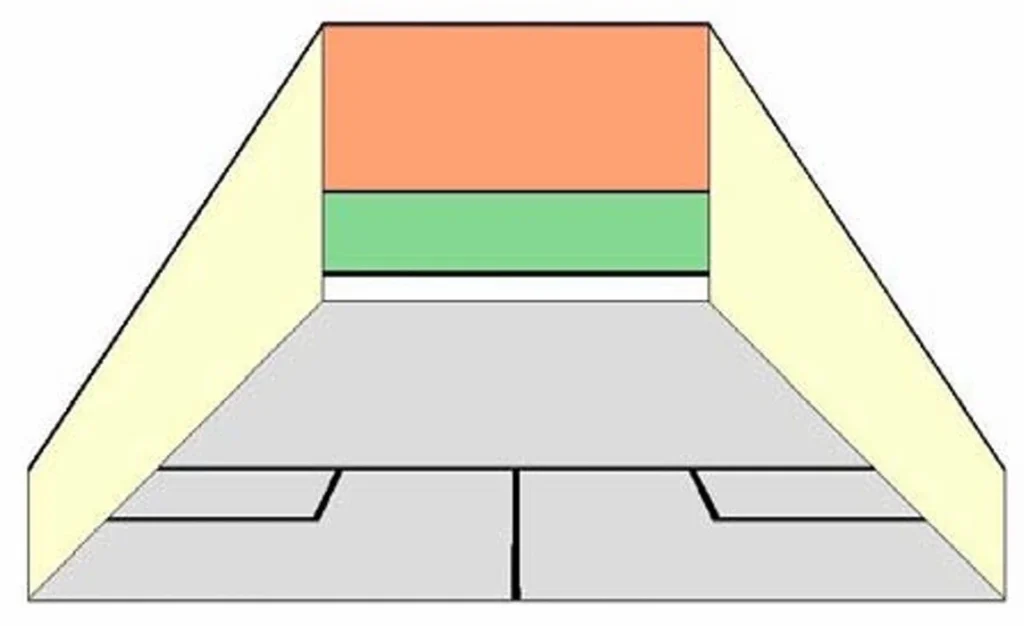
Each of the side walls shall be one colour and each side wall shall be the same colour.
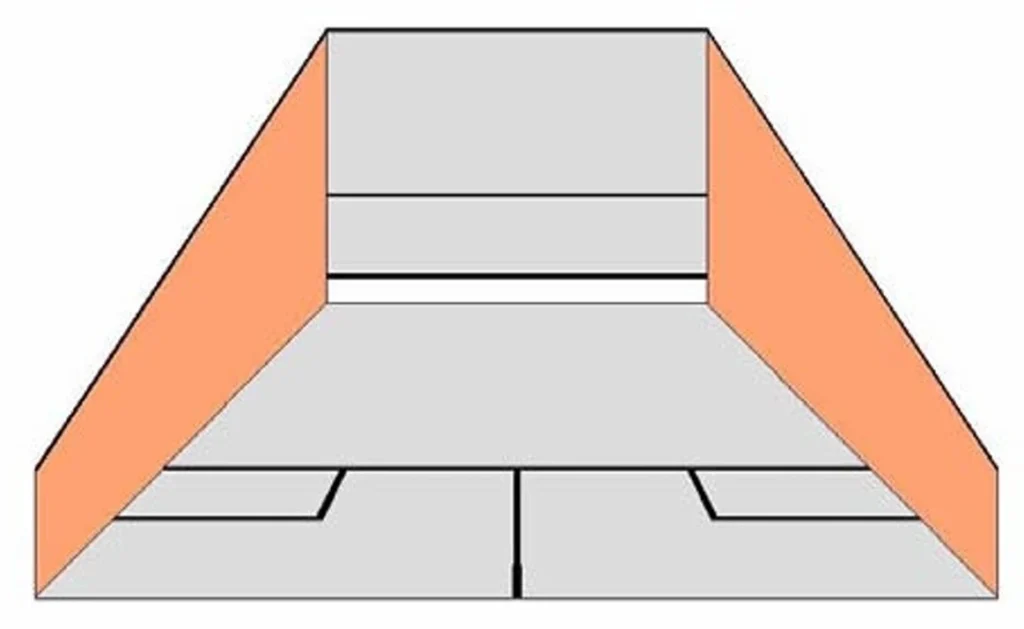
The front wall may be two colours, one below and one above the service line. The front wall colours need not be the same colour as the side wall colours.
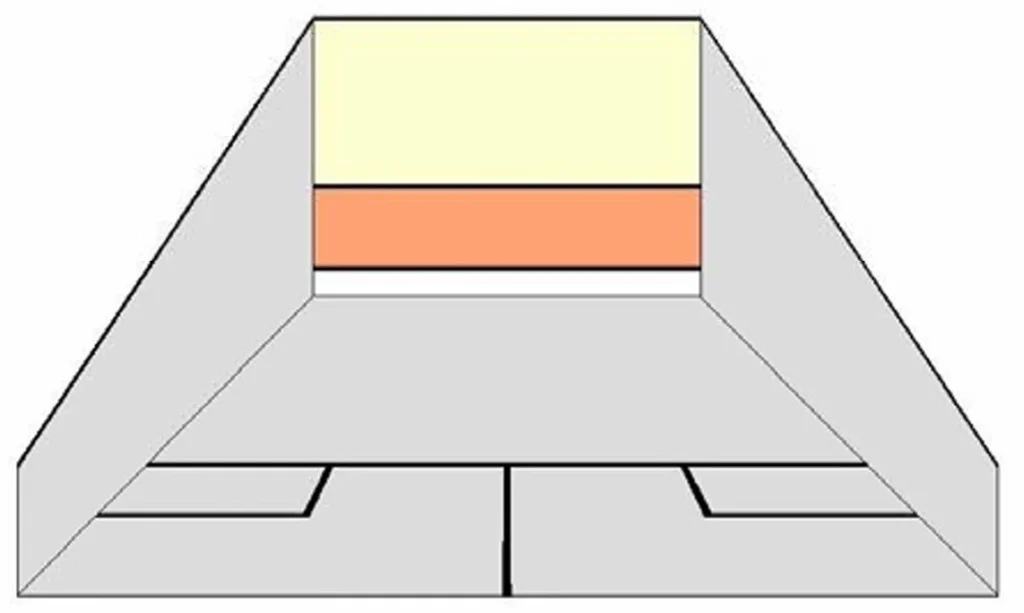
The floor shall have no more than two colours and each colour shall be bounded on at least two sides by the floor markings. The use of colours shall be symmetrical about the half court line. Natural wood materials shall be considered to be one colour providing the whole complies.
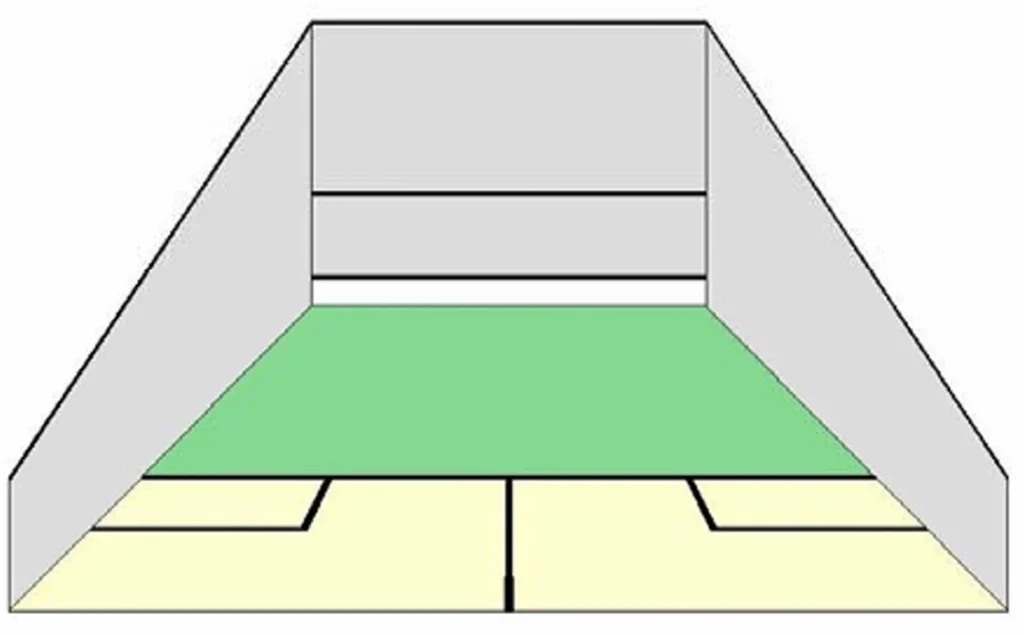
All colours shall have a minimum reflectance value of 50% and all colours shall be of the same reflectance value + or – 10%.
Colours will be permitted on all new and existing courts providing that the average illumination does not fall below the recommended standard of 500 lux or the minimum standard of 300 lux.
Out of court wall surfaces shall have a reflectance value the same or higher than any of the colours used on the play wall surfaces.
The ceiling shall have a minimum reflectance value of 80%.
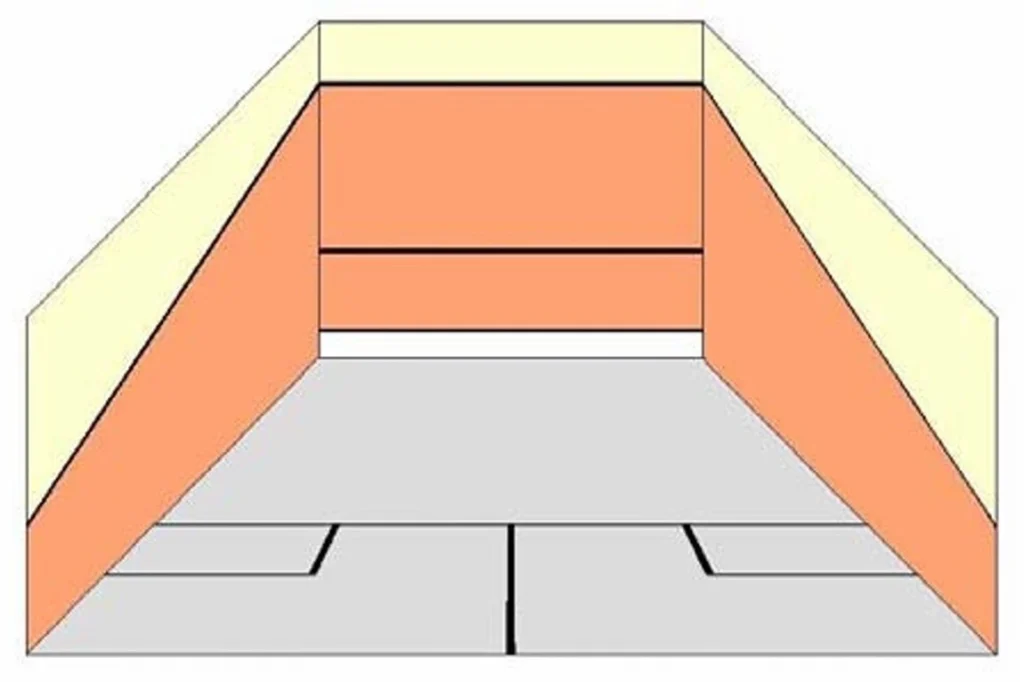
Stripes or patterns of any type will not be permitted on the wall playing surfaces except on the back wall up to a height of 750mm and on the front wall at a minimum height of 3600mm above the floor where a logo, club or sponsors name may be used providing it is not more than 750mm square and is located central on the front wall.
The minimum reflectance value of any of the colours used in any logo or name shall be 30%.
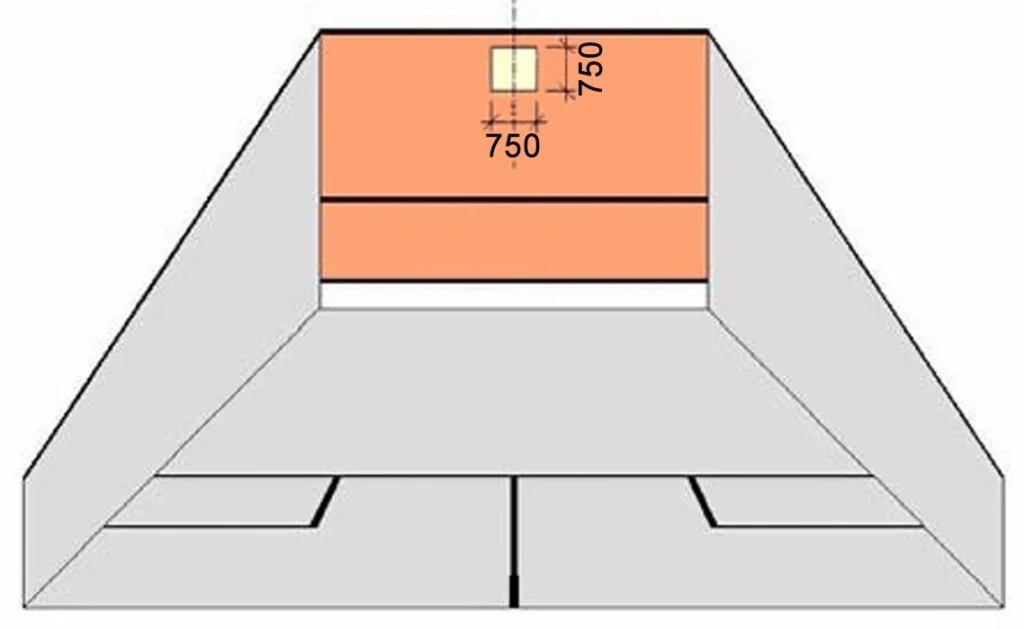
A logo, club or sponsors name on the floor will not normally be permitted however individual designs may be specifically approved by the WSF upon request.
The minimum reflectance value of any of the colours used in any logo or name shall be 30%.
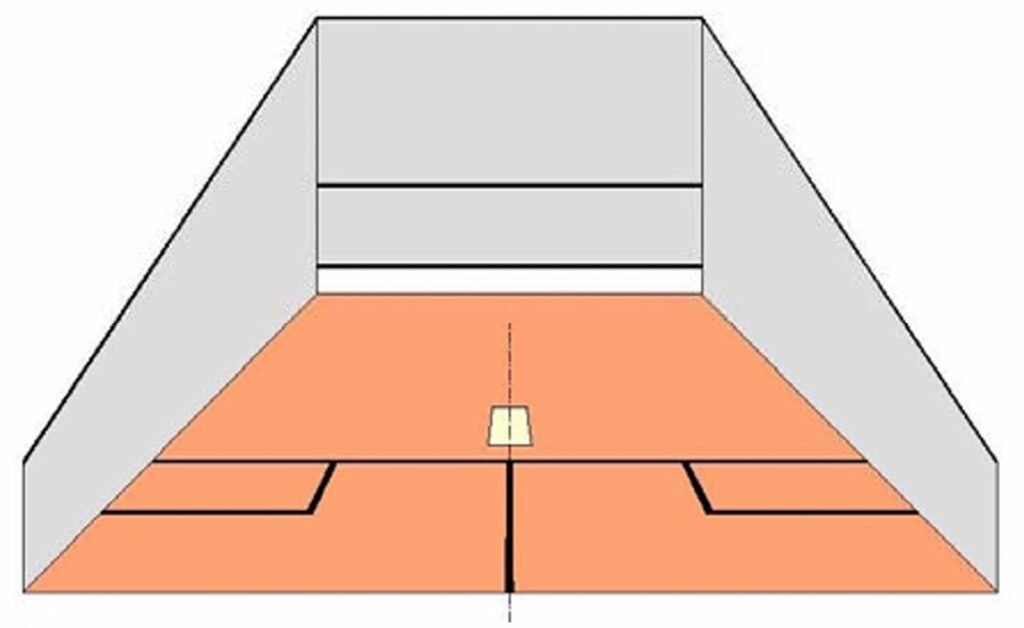
The Tin, below the top 50mm, may be of any colour and contain advertising, logos, club or sponsors names providing no part has a reflectance value of less than 30%.
The court play lines may be any colour providing they contrast with all colours used on adjoining play surfaces. Wall play lines need not be the same colour as floor play lines.
Patterns and coaching aids on either the floor or the walls will not normally be permitted however individual designs may be specifically approved by the WSF upon request and following play testing to determine ball visibility.
All lines colours or other markings on the floor shall be anti-slip in accordance with the Squash Court Specification.
